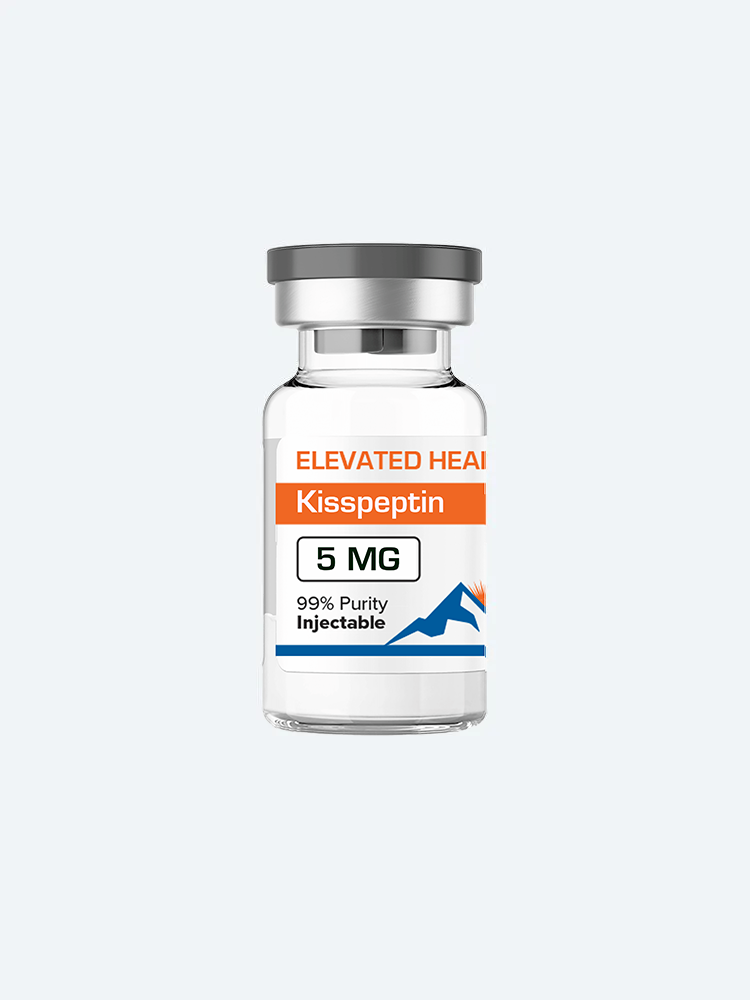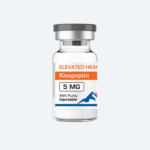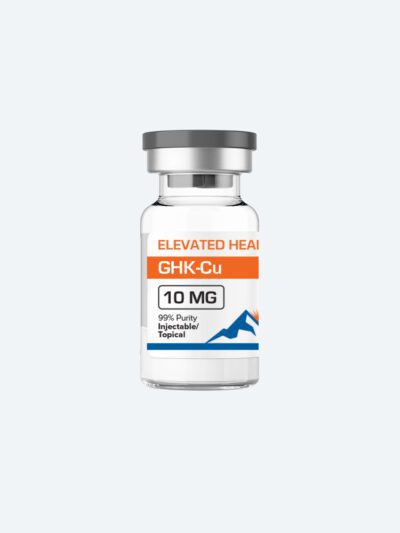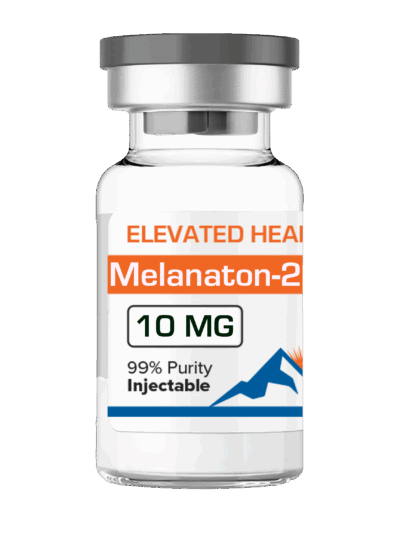No products in the cart.
Back


In stock
Kisspeptin-10 Peptide
Fertility, Men's Health, Mood Boosting, Peptides$60.00
SKU: 29045-SB-9-55
5 mg
Injectable
Ingredients – 5mg Kisspeptin-10 Peptide
Indications – Fertility improvement via increase in circulating LH and FSH levels, improves testosterone levels in men, improves sperm quality and abundance
Dosage – 100-200mcgs, 2-3 times per week
Kisspeptin-10 is a naturally occurring peptide protein encoded by the KISS1 gene.(2) Kisspeptin is a product of the KISS1 gene, produced by the cleavage of the original 145-amino acid polypeptide to a smaller peptide. Kisspeptin-10 is a 54 amino acid peptide which is considered to be a product of the KISS1 gene. This smaller peptide is cleaved further to become Kisspeptin 45-54, also known as Kisspeptin 10.(6)
KISS1 is a gene that is considered to suppress metastases of melanomas and breast carcinomas, thereby inhibiting abnormal cell growth and potentially preventing cancer.(2) Initially considered to be a metastasis suppressor, Kisspeptin-10 was later suggested to possess a different expression profile, which may potentially allow it to function on the hypothalamus and pituitary gland, thereby impacting the reproductive system.(3)
Several independent studies in the mid-2000s suggested that Kisspeptin-10 may play a role in hypogonadotropic hypogonadism, as the peptide is considered to be a ligand of the G-protein coupled receptor 54 (GPR54).(5)
Hypogonadism is a system disorder wherein reproductive organs produce less or no sex hormones. One of the forms of hypogonadism is called hypogonadotropic hypogonadism, where the organism suffers from hypogonadism due to under-functioning of the pituitary gland or hypothalamus.(1) GnRH is considered to stimulate the pituitary gland to release follicle-stimulating hormone (FSH) and luteinizing hormone (LH). Both FSH and LH are considered to regulate reproductive function.(1) Lack of these hormones, i.e. GnRH, FSH, and LH, are considered the main factors of hypogonadotropic hypogonadism.
- Description
REMINDER TO ALL CUSTOMERS:
Due to their sensitive nature and strict storage requirements: all sales are final on peptides & GH products. We cannot accept returns strictly because of product integrity and safety for all clients. Thank you for your understanding
Increasing Testosterone
By affecting circulating levels of LH and FSH, kisspeptin can alter testosterone levels. This alteration, however, appears to be sex specific. In men, kisspeptin increases testosterone levels while in women it has no discernible impact on testosterone. In one study, 6 men were administered a derivative of kisspeptin via IV. They showed a significant increase in plasma testosterone levels (nearly 3-fold) after just 90 minutes[1]. A different analog of kisspeptin has been found to alter the pulse frequency of LH in men, suggesting that kisspeptin helps to fine tune the normal pulsatile release of sex hormones. A study of healthy men given kisspeptin-10 revealed a rapid and dose-dependent increase in serum LH levels and a concomitant increase in testosterone levels. Kisspeptin-10 appears to achieve this feat by increasing the pulsatile release of LH. If given at high enough doses, kisspeptin-10 causes such rapid pulsation as to obscure individual pulses entirely, resulting in continuous LH release[2]. This finding opens the door for potential uses of kisspeptin and its analogues in a variety of settings from pregnancy to low testosterone levels and more.
Boosting Gonadotropin Releasing Hormone
Gonadotropin-releasing hormone (GnRH) is synthesized in and released from GnRH neurons in the hypothalamus. It is the first hormone released in the hypothalamic-pituitary-gonadal axis and controls the release of follicle-stimulating hormone (FSH) and luteinizing hormone (LH) from the anterior pituitary gland. GnRH is the primary driver of puberty and controls the maturation of gametes in the genitals. It is used therapeutically to control menstruation in select settings, as a treatment for precocious puberty, and as a continuous infusion in certain types of cancer.
Kisspeptin-10’s Potency in Stimulating LH Levels
This hormone, called gonadotropin, regulates ovulation and testosterone production by enhancing LH secretion. The dosage of Kisspeptin-10 is a significant factor in this process, as it affects the pituitary gland’s response to gonadotropin-releasing hormone (GnRH).
In females, luteinizing hormone (LH) and follicle-stimulating hormone (FSH) are gonadotropins synthesized by the pituitary gland. These hormones are crucial in initiating ovulation, ensuring the timely release of fully developed eggs from the ovaries. Additionally, gonadotropin-releasing hormone (GnRH) regulates LH and FSH production.
In males, the hypothalamus secretes gonadotropin-releasing hormone (GnRH) in rhythmic pulses to regulate follicle-stimulating hormone (FSH), promoting and maintaining proper reproductive function. Spermatogenesis in the seminiferous tubules. Its primary action is to stimulate the pituitary gland, triggering the release of gonadotropins.
This rapid response demonstrates the potency of GnRH peptide in stimulating LH secretion in the seminiferous tubules . KP is also implicated in this process.
The ability of Kisspeptin-10 to enhance testosterone release in rats is particularly noteworthy for men facing issues related to low testosterone levels. The effects were observed within a few days of administration.
Kisspeptin’s Reproductive Function
As part of one 2017 study,(10) a literature review was conducted for all articles published from 1999 to 2016. Upon review of the articles, it was suggested that experimental data may support the hypothesis that the Kisspeptin-10 system (including the KISS1 gene and its products, GPR54 receptors) may possibly regulate the release of gonadotropin hormones.
Furthermore, certain studies were conducted in experimental animal models with similar characteristics as hypogonadotropic hypogonadism (HH) and polycystic ovarian syndrome (PCOS). These studies suggested that reproductive disorders such as HH and PCOS may occur due to abnormalities in the KISS1 and GPR54 system. The outcome of this literature review suggested that Kisspeptin-10 may be a neuropeptide regulator of GnRH release.
Cancer Research from Kisspeptin
Twenty years ago, it was discovered that kisspeptin is capable of suppressing metastasis of melanoma (malignant skin cancer) by as much as 95%. It appears that the peptide produces this effect by reducing cancer cell migration. There is also some question as to whether kisspeptin can reduce cell adhesion and thereby prevent cancer cells from sticking to other tissues and invading them. Screening of a variety of metastatic cancer types reveals that breast, bladder, GI, prostate, pancreatic, ovarian, skin, and thyroid cancers all show changes (generally decreases) in kisspeptin levels, confirming that the peptide plays a role in the spread of cancer[4].
The interest in kisspeptin for the treatment of cancer has waxed and waned as a result of the incredible complexity of this peptide. Research is ongoing to understand exactly how the peptide can be manipulated, cut, recombined, and altered to produce effects in various cancer types. It is not so much that the peptide doesn’t work but rather than kisspeptin has so many effects that teasing out its precise impact on various cancer cells is difficult[5]. Dr. Floriana Morgillo implores researchers to take on the complexities of kisspeptin to realize the tremendous potential of this peptide to treat cancer. As she points out, kisspeptin could block metastasis in multiple organs and drastically reduce disease burden, adding years to lifespan of cancer patients and making it easier for current treatments to induce remission.
An interesting connection between kisspeptin, melatonin, and cancer was discovered only in the early months of 2020 when an experiment linked levels of the peptides to exposure to daylight. In the experiment, mice exposed to daylight and darkness showed drastically different levels of melatonin and kisspeptin. Those exposed to daylight had high kisspeptin levels and low melatonin levels. The opposite was true of those kept in the dark. To add to the experiment’s value, the mice were injected with melanoma cells. It turns out that the daylight mice had high tumor growth rates and tumor volume. No measure was made of metastasis. It appears that melatonin and kisspeptin are both involved in tumor suppression such that one influences the other, but the exact connection remains unknown[6]. This is just one example of the complex ways in which kisspeptin interacts with the body to alter tumor growth.
For years it has also been understood that kisspeptin has the potential to influence the growth and metastasis of cancerous cells. Studies have been somewhat contradictory, however, leading to periods of waxing and waning interest in using kisspeptin as a treatment in chemotherapy regimens. The ability o the peptide to influence metastasis may be linked to its role in vascular growth and functioning. Right now, kisspeptin is the subject of a number of intensive trials aimed at deepening our understanding of this versatile and potentially life-saving peptide.
Emotional Modulation
Just like reproduction and energy status are interconnected, so too are reproduction and emotion interconnected. Given the role of kisspeptin in both reproduction and energy homeostasis, researchers questioned how the peptide might influence emotion and behavior. To test this connection, they compared kisspeptin to placebo administration in 29 healthy heterosexual men. Individuals given kisspeptin showed enhanced limbic brain activity. In particular, the individuals showed increased reward-seeking behavior, increased drive, and improved overall mood[8]. It would appear that kisspeptin plays a role in integrating sexual and emotional brain processing with the overall process of reproduction. These findings help to further our understanding of mood, motivation, and drive not just as they relate to sex, but as they relate to human behavior in general.
In addition to its memory-enhancing properties, kisspeptin-10 has shown promise in boosting mood. Further rodent studies have suggested that peripheral administration of kisspeptin leads to effects similar to antidepressants. Notably, it enhanced activity in the frontal regions of the brain when the subjects were exposed to negative visual stimuli, consequently mitigating negative emotional responses.
Extrapolating these findings to humans, a study involving 29 healthy young men revealed that kisspeptin administration heightened activity in limbic regions of the brain. This region is crucial for emotions and mood regulation. The participants displayed improved psychometric scores related to reward, motivation, and mood, alongside a reduction in negative emotional states.
Neuroprotection
The accumulation of amyloid-beta (Aβ) and alpha-synuclein (α-syn) within cholinergic neurons is believed to damage and potentially cause dysfunction within important central nervous system structures. However, it has been proposed that Kisspeptin-10 may attach to Aβ on the outside of cells, which may, in turn, possibly reduce the harmful actions of Aβ.(16) Studies have suggested that Kisspeptin-10 peptides may counteract the damaging actions of Aβ, prion protein (PrP), and Islet Amyloid Polypeptide (IAPP) without being hindered by the antagonists of the kisspeptin receptor (GPR-54) or the neuropeptide FF (NPFF) receptor. Given the resemblance between the non-amyloid-β component (NAC) of α-syn and the C-terminus of Aβ, it has been speculated that Kisspeptin-10 might also lessen the toxicity caused by α-syn in cholinergic neurons.(17) Research involving cholinergic cells has indicated that while high concentrations of Kisspeptin-10 may increase toxicity, lower concentrations may potentially decrease the toxicity induced by both the wild-type and the E46K mutant forms of α-syn. Computational studies have supported these observations by suggesting a potentially actionable interaction between Kisspeptin-10 and the C-terminal residues of α-syn. The molecular dynamics simulations indicated that the complexes formed between Kisspeptin-10 and α-syn appeared to have demonstrated good stability.
Researchers have also delved into investigating whether the activation of GPR54 (the receptor for the Kisspeptin gene) is crucial for the potential of Kisspeptin-10 to bind to the C-terminal pockets of α-syn. In one study, ChAT-positive SH-SY5Y neurons were genetically modified to produce either the wild-type or the E46K mutant version of α-syn, and the actions of Kisspeptin-10 on the neuronal damage caused by α-syn were assessed through flow cytometry and immunocytochemistry methods.(18) Results suggested that Kisspeptin-10 may have lessened both apoptosis and mitochondrial damage in cholinergic neurons affected by either form of α-syn. Notably, the seeming protective action of Kisspeptin-10 did not appear to be impacted when introduced alongside a GPR54 antagonist, kisspeptin-234 (KP-234), implying that the activation of GPR54 may not be necessary for the actions of Kisspeptin-10. Additionally, it was observed that Kisspeptin-10 may have reduced the presence of α-syn and choline acetyltransferase (ChAT) in neurons that overexpressed the wild-type and E46K mutant α-syn, further highlighting its potential neuroprotective capacity.
Studied Memory Enhancement
It appears that certain analogs to kisspeptin are important in the areas of the brain responsible for memory consolidation and orientation in 3-D space. Research in mice suggests that administration of these peptides can help to reverse the learning and navigational impairment often seen in ethanol intoxication[7]. This suggests that kisspeptin and its analogues play a role in the ability of neurons to encode information and may make these peptides of potential interest in offsetting learning deficits seen in certain genetic and chronic disease situations. While this research is in its early stages, it helps to widen our understanding of learning and push us further toward the development of nootropics that can help to stimulate both health and damaged brains to improve function.
References:
Hypogonadotropic hypogonadism. US National Library of Medicine. https://medlineplus.gov/ency/article/000390.htm
KISS1 KiSS-1 metastasis suppressor [Homo sapiens (humans)]. https://www.ncbi.nlm.nih.gov/gene/3814
Hussain, Mehboob A et al. “There is Kisspeptin – And Then There is Kisspeptin.” Trends in endocrinology and metabolism: TEM vol. 26,10 (2015): 564-572. https://www.ncbi.nlm.nih.gov/pmc/articles/PMC4587393/
Pasquier, J., Kamech, N., Lafont, A., Vaudry, H., Rousseau, K., & Dufour, S. (2014). MOLECULAR EVOLUTION OF GPCRS: Kisspeptin/kisspeptin receptors, Journal of Molecular Endocrinology, 52(3), T101-T117. https://jme.bioscientifica.com/view/journals/jme/52/3/T101.xml
Messager, S., Chatzidaki, E. E., Ma, D., Hendrick, A. G., Zahn, D., Dixon, J., Thresher, R. R., Malinge, I., Lomet, D., Carlton, M. B., Colledge, W. H., Caraty, A., & Aparicio, S. A. (2005). Kisspeptin directly stimulates gonadotropin-releasing hormone release via G protein-coupled receptor 54. Proceedings of the National Academy of Sciences of the United States of America, 102(5), 1761–1766. https://www.ncbi.nlm.nih.gov/pmc/articles/PMC545088/
Mead, E. J., Maguire, J. J., Kuc, R. E., & Davenport, A. P. (2007). Kisspeptins: a multifunctional peptide system with a role in reproduction, cancer and the cardiovascular system. British journal of pharmacology, 151(8), 1143–1153. https://www.ncbi.nlm.nih.gov/pmc/articles/PMC2189831/
Rønnekleiv, O. K., & Kelly, M. J. (2013). Kisspeptin excitation of GnRH neurons. Advances in experimental medicine and biology, 784, 113–131. https://www.ncbi.nlm.nih.gov/pmc/articles/PMC4019505/
Prague JK, Dhillo WS. Potential Clinical Use of Kisspeptin. Neuroendocrinology. 2015;102(3):238-45. doi: 10.1159/000439133. Epub 2015 Aug 7. https://pubmed.ncbi.nlm.nih.gov/26277870/
Tng E. L. (2015). Kisspeptin signalling and its roles in humans. Singapore medical journal, 56(12), 649–656. https://www.ncbi.nlm.nih.gov/pmc/articles/PMC4678402/
Zeydabadi Nejad, S., Ramezani Tehrani, F., & Zadeh-Vakili, A. (2017). The Role of Kisspeptin in Female Reproduction. International journal of endocrinology and metabolism, 15(3), e44337. https://www.ncbi.nlm.nih.gov/pmc/articles/PMC5702467/
Stengel, A., Wang, L., Goebel-Stengel, M., & Taché, Y. (2011). Centrally injected kisspeptin reduces food intake by increasing meal intervals in mice. Neuroreport, 22(5), 253–257. https://www.ncbi.nlm.nih.gov/pmc/articles/PMC3063509/
Orlando G, Leone S, Ferrante C, Chiavaroli A, Mollica A, Stefanucci A, Macedonio G, Dimmito MP, Leporini L, Menghini L, Brunetti L, Recinella L. Effects of Kisspeptin-10 on Hypothalamic Neuropeptides and Neurotransmitters Involved in Appetite Control. Molecules. 2018 Nov 24;23(12):3071. doi: 10.3390/molecules23123071. PMID: 30477219; PMCID: PMC6321454.
Kristen P. Tolson et.al, Impaired kisspeptin signaling decreases metabolism and promotes glucose intolerance and obesity. The Journal of Clinical Investigation. Published June 17, 2014. https://www.jci.org/articles/view/71075
Chan, Y. M., Lippincott, M. F., Kusa, T. O., & Seminara, S. B. (2018). Divergent responses to kisspeptin in children with delayed puberty. JCI insight, 3(8), e99109. https://www.ncbi.nlm.nih.gov/pmc/articles/PMC5931121/
Comninos, A. N., Wall, M. B., Demetriou, L., Shah, A. J., Clarke, S. A., Narayanaswamy, S., Nesbitt, A., Izzi-Engbeaya, C., Prague, J. K., Abbara, A., Ratnasabapathy, R., Salem, V., Nijher, G. M., Jayasena, C. N., Tanner, M., Bassett, P., Mehta, A., Rabiner, E. A., Hönigsperger, C., Silva, M. R., Dhillo, W. S. (2017). Kisspeptin modulates sexual and emotional brain processing in humans. The Journal of clinical investigation, 127(2), 709–719. https://www.ncbi.nlm.nih.gov/pmc/articles/PMC5272173/
Milton NG, Chilumuri A, Rocha-Ferreira E, Nercessian AN, Ashioti M. Kisspeptin prevention of amyloid-β peptide neurotoxicity in vitro. ACS Chem Neurosci. 2012 Sep 19;3(9):706-19. doi: 10.1021/cn300045d. Epub 2012 May 30. PMID: 23019497; PMCID: PMC3447396.
Simon, C., Soga, T., Ahemad, N., Bhuvanendran, S., & Parhar, I. (2022). Kisspeptin-10 Rescues Cholinergic Differentiated SHSY-5Y Cells from α-Synuclein-Induced Toxicity In Vitro. International journal of molecular sciences, 23(9), 5193. https://doi.org/10.3390/ijms23095193
Simon, C., Soga, T., & Parhar, I. (2023). Kisspeptin-10 Mitigates α-Synuclein-Mediated Mitochondrial Apoptosis in SH-SY5Y-Derived Neurons via a Kisspeptin Receptor-Independent Manner. International journal of molecular sciences, 24(7), 6056. https://doi.org/10.3390/ijms24076056
W. S. Dhillo et al. “Kissentin-54 stimulates the hypothalamic-pituitarv aonadal axis in human males,” J. Clin. Endocrinol. Metab., vol. 90, no. 12, pp. 6609-6615, 009-1468
J. T. George et al.. “Kisspeptin-10 is a potent stimulator of LH and increases pulse frequency in men.” J. Clin. Endocrinol. Metab., vol. 96. no. 8, pp. E1228-1236, Aug 2011, do: 10.1210/jc.2011-0089.
C. J. L. Harter, G. S. Kavanagh, and J. T. Smith, “The role of kisspeptin neurons in reproduction and metabolism.” J. Endocrinol.. vol. 238, no. 3, pp. R173-R183 2018, doi: 10.1530/JOE-18-0108.
E. J. Mead. J. J. Maquire. R. E. Kuc. and A. P. Davenport. “Kisspeptins: a multifunctional peptide system with a role in reproduction. cancer and the cardiovascular system,” Br. J. Pharmacol., vol. 151, no. 8, pp. 1143-1153, Auc 2007, doi: 10.1038/sj.bjp.0707295.
T. Ly. S. Harihar, and D. R. Welch, “KISS1 in metastatic cancer research and treatment potential and naradoxes ” Cancer Metastasis Rey Mar 2020 doi 10 107/10555-020-09868.9
P. Pazarci et al., “The effects of daylight exposure on melatonin levels, Kiss 1 expression, and melanoma formation in mice,” Croat. Med. J., vol. 61, no. 1, pp. 55261 Feb 2020
E. Gibula-Tarlowska and J. H. Kotlinska. “Kissorohin improves spatial memorv and
cognitive flexibility impairment induced by ethanol treatment in the Barnes maze task in rats,” Behav. Pharmacol., vol. 31, no. 2 & 3, pp. 272-282, Apr. 2020
A N Comninos et al “Kissentin modulates seyual and emotional brain processing in humans.” J. Clin. Invest. vol. 127. no. 2. op. 709-719. doi 10 1172/IC|89519
M. Bhattacharva and A. V. Babwah. “Kissentin: Bevond the Brain.” Endocrinoloav vol. 156. no. 4, pp. 1218-1227. Apr. 2015, doi: 10.1210/en.2014-1915.
Antitumor efficacy of Kisspentin in human malianant mesothelioma cells PubMed Central PMC\. httos://www.ncbi.nlm.nih.gov/omc/articles/PMC5922395,
Related products
- GHK-Cu, 50mg - 3 Pack
$210.00Original price was: $210.00.$189.00Current price is: $189.00. - Melanotan-2$50.00
- AOD-9604, 5mg$80.00






